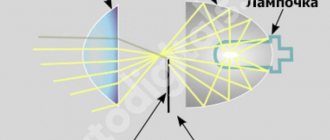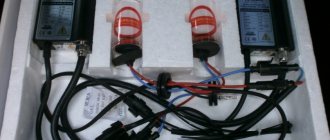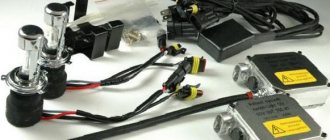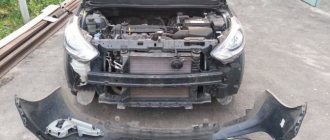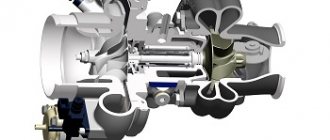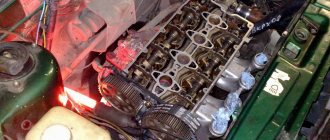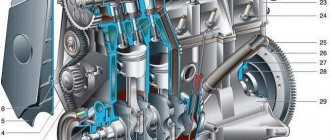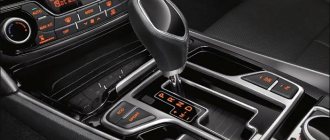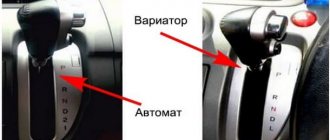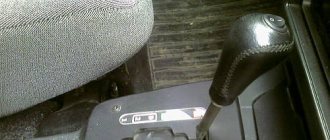Dear readers! Our article is for informational purposes only, which does not imply the provision of services described in the article!
When a driver decides to equip a car with bright and long-lasting light, the question arises of choosing between LEDs, xenon (Xenon) and bi-xenon (BiXenon). While the difference between LED headlights and xenon is clear, the difference between xenon and bi-xenon is not so clear. In the article we will understand the principle of operation of xenon and bi-xenon and their differences.
The principle of operation of xenon and bi-xenon
In halogen lamps, the glow is created by an incandescent filament; they produce dim light, do not last long and often fail. Xenon and BiXenon operate on the basis of gas-discharge lamps. Structurally, it looks like this: between two current sources there is a flask with a special gas, a high-voltage discharge passes in an inert gas environment and creates bright, intense radiation. No filaments or other elements. But the main difference between xenon and bi-xenon is the distribution of the direction of the glow.
Principle of operation
Xenon headlights use an inert gas, which glows due to two electrical contacts on different sides. When high electrical voltage (several thousand volts) passes through the inert gas that fills the lamp, it begins to glow. The battery, as you know, produces only 12 volts, and this voltage is converted by the ignition unit, also called a pulsed “ignition device”. The glow of gas-discharge lamps is not discrete, but constant. This creates a bright source of diffused light.
If you add curtains, the light can be directed to a specific place, and it will become directional.
The color of xenon glow directly depends on its temperature:
- 3000 K - yellow tint. This xenon is well suited for fog lights.
- 4300 K - golden light. Will provide the brightest and longest beam of light.
- 5000K is standard white light.
- 6000 K - white-blue tint.
- 8000 K - bright blue glow.
- 10000 K - dark blue color with a purple tint.
- 12000 K - violet-lilac glow.
The most common xenon headlight bulbs produce standard white light. In second place is the white-blue shade.
The principle of luminescence of gas-discharge lamps
The peculiarity of the glow of standard xenon lamps is that they shine simultaneously in all directions. Therefore, Xenon cannot be used in fog lights, they wrote about this in the article: “Can xenon be installed in fog lights?” It doesn't create a top dark border or create a wide low light wash over the road. If you install it in the PTF, the driver will see only a white wall in front of him during fog. For these reasons, it is advisable to use gas-discharge lamps in low-beam or high-beam headlights.
Fans of city driving use xenon in the low beam and leave halogen in the high beam. But if a motorist often travels along country roads, it is worth choosing BiXenon headlights. Next we will tell you what the difference is between xenon and bi-xenon.
Is it possible to change xenon to halogen and vice versa?
These are fundamentally different light bulbs. A halogen light bulb has an incandescent filament (spiral), which heats the gases and tungsten vapors in the bulb, causing them to glow. Their internal temperature can reach 3500 °C. Naturally, the design of the headlight itself, the materials from which it is made, and the reflector are designed for such a temperature. If by chance a halogen lamp fits the base and size of the headlight where the standard factory xenon is installed, you should not change the xenon to halogen. The reflector can quickly burn out and even plastic parts can become deformed from high temperatures, since they are not designed for such high temperatures.
The reverse replacement (halogen to xenon) is also not recommended. Yes, xenon lamps are more modern, more economical, shine brighter with less energy consumption, and generate less heat inside the headlight. But even if a xenon lamp is suitable in size and base instead of the standard factory halogen lamp provided by the manufacturer, such a replacement can cause two problems.
- On-board computers on modern cars automatically disconnect burned out light bulbs from power. Xenon consumes less W, and the computer can evaluate this as “the light bulb has burned out” and turn it off or report a problem or issue an error.
Sometimes additional resistors are installed to increase xenon energy consumption to standard values. But this makes the system more complex, more expensive, and negates the energy saving benefits.
- A non-standard xenon lamp, instead of a standard halogen lamp, has a different shape of the luminous area inside the lamp. Even if it fits the base and size. As a result, the light from it is scattered not down onto the road, as intended by the car’s designers, but in different directions. This includes blinding oncoming drivers. It cannot be otherwise, since the shape of the reflector is calculated in laboratories down to a fraction of a degree of inclination based specifically on a specific standard lamp.
Sometimes they still install xenon instead of the standard halogen. But after such tuning, it is necessary to adjust the changed light flow at the stand in specialized services. Otherwise, a non-standard lamp can shine anywhere, but not where it is needed.
What is the difference between xenon and bi-xenon?
The bi-xenon headlight contains a gas-discharge lamp similar to xenon, but it is equipped with a special mechanism that is responsible for changing the direction of the light flux. The mechanism resembles a metal curtain that moves from a magnet and creates dark boundaries, redistributing the flow. This design feature led to the use of bi-xenon instead of xenon in combination headlights. Therefore, it is possible to try installing bi-xenon in fog lights, unlike xenon.
The answer to the question “how to distinguish xenon from bi-xenon” is by the presence of a special mechanism for regulating the light flux.
Is there a penalty for using bi-xenon lamps?
For the use of xenon lamps in headlights, the factory design of which is not designed for their use, the Code of Administrative Offenses of the Russian Federation provides for punishment.
Non-standard xenon can blind other road users due to the lack of an automatic light beam corrector and headlight washers, incorrect scattering angle of reflected radiation, and mismatch of the reflective surface class. This is a violation of safe road traffic conditions.
Illegal xenon blinds drivers of oncoming and passing vehicles
According to Article 12.4 Part 1 of the Code of Administrative Offenses of the Russian Federation, “for the installation of light devices on the front of a vehicle, the color of the lights and the operating mode of which do not comply with the requirements of the Basic Provisions for the admission of a vehicle to operation and for ensuring road safety, an administrative fine of 3,000 rubles is expected to be imposed on citizens. , for officials 15-20,000 rubles, legal entities 400-500,000 rubles.” with confiscation of lamps and ignition units.
Police officers have the right to draw up a report on driving a vehicle with defects.
For driving a vehicle with installed lighting devices, the color and mode of operation of which do not comply with the requirements of Article 12.5, paragraph 3, deprivation of rights is provided for for a period of 6 to 12 months with retaking the exam on knowledge of traffic rules and confiscation of these devices and devices.
Stopping the vehicle to check whether the headlights comply with the standards is carried out at a stationary post. Only the technical supervision inspector is authorized to carry out the inspection after providing the certificate.
Color and placement of lighting fixtures do not match art. 12.5 clause 3.1 – deprivation of rights.
Xenon and bi-xenon in headlights intended for halogen lamps are classified as a discrepancy between the operating mode of the external lighting device and the technical characteristics of the vehicle and is regarded as a vehicle malfunction:
- clause 3.1: “The number, type, color, location and operating mode of external lighting devices do not meet the requirements of the vehicle design”
- clause 3.4: “There are no lenses on the lighting devices or lamps and lenses that do not correspond to this type of lighting device are used.”
Only a court can deprive the right to drive a vehicle (Article 3.8 of the Code of Administrative Offenses of the Russian Federation). Police officers do not have such powers. The court decision can be appealed to a higher court.
Is it possible to install xenon in a car? It is described in the vehicle operating instructions. The absence of markings on the headlight and information in the manual means that the installation of xenon is illegal and entails the same punishment for use in headlights and in PTF.
Read more here: Is it possible to drive with xenon headlights according to traffic rules?
The difference between xenon and bi-xenon is clear
This is what Xenon lamps look like; they do not have mechanisms that direct the flow of light.
These are BiXenon lamps with special magnetic mechanisms.
How to make the right choice
Experts and experienced car enthusiasts advise using bi-xenon lamps. If the cost of bi-xenon is not in your budget, you can use a popular combination - halogen lamps for high beam and xenon lamps for low beam. This combination is popular for one simple reason - high beams are only needed on long and night trips, and according to statistics, 90% of people mainly make short trips during the day.
It is quite easy to distinguish high-quality lamps from low-quality ones. High-quality xenons are bright and durable. The brightness of good xenons can exceed analogues by 20-30%. This superiority is ensured by the installation of D series lamps (D1R, D1S, D2R, D2S, D4R, D4S) and a temperature of 4300 K. Also, lamps with D socket are durable. Good xenons should have short circuit protection, and the wiring should be completely insulated. If this rule is not followed, in addition to xenons or bi-xenons, other automotive electronics will also suffer.
When choosing xenon, you need to take into account that it comes in two types: standard and Chinese.
Differences between standard xenons:
- high brightness (due to high-quality manufacturing and well-selected parameters);
- ignition time 3−4 seconds;
- long service life;
- the presence of protective circuits against short circuits and open circuits;
- when the lamp burns out, the ignition unit does not burn out;
- service life of blocks (from 2−3 years).
Differences between Chinese analogues:
- brightness is 20−30% lower than originals;
- original lamps sometimes do not fit Chinese blocks;
- high-voltage wiring is not protected and is located outside the unit body, which can lead to serious damage to all vehicle electronics;
- due to the lack of protection, the unit itself burns out along with the lamp;
- block service life (up to one and a half years).
Thus, the car enthusiast has a choice. You can buy cheap Chinese analogues or expensive brand lamps. If you take cheap analogues, their brightness will be 5-10% lower than the original ones, and their service life will not be very pleasing. Branded xenons will be guaranteed to work for at least 2 years, but usually their service life is 4 years or more. During this time, the thrifty car enthusiast will have to change several pairs of cheap headlights.
Another important selection factor is the time until the lamps are completely ignited. For branded xenons with a D base it is 3-4 seconds, while analogs can flare up to the end only after 20 minutes of operation. Good characteristics of xenon are: base D, protection against short circuit and burnout , insulation of wires inside the housing. Such analog lamps, of course, can be found, but you won’t be able to achieve much savings.
Xenon and bi-xenon
- Both options operate on the basis of gas-discharge lamps.
- Equally bright, durable and reliable.
- Xenon is installed in the low-beam or high-beam headlights of a car; the BiXenon headlight combines both options in one housing and makes it possible to switch from one to another type of road lighting.
- Switching the light and changing the direction of the light flow occurs due to the movement of a special mechanism that forms a directed flow.
- With BiXenon you can replace a double-filament lamp.
- The cost of bi-xenon headlights is higher than xenon.
What is bi-xenon
The physical principle by which they operate is exactly the same as that of xenon lamps: the formation of an electrical discharge in an inert gas, accompanied by light radiation. The only difference is that bi-xenon lamps combine the functions of low and high beam. As a matter of fact, this is exactly what the prefix “bi” indicates.
In order to “get around” the limitation associated with the stability of the luminous flux, the design engineers of this light source resorted to a small, but ultimately very effective trick. Inside the lamp they placed a specialized device, which is a so-called lamp screen. It is a luminous flask that can move under the control of a special magnet. As a result, it turns out that in different spatial positions the screen-lamp provides a different luminous flux. Thus, the bi-xenon switches from low beam to high beam.
What is better xenon or bi-xenon?
Depends on needs and capabilities. If your car does not have separate optics, choose bi-xenon headlights. If you rarely go outside the city and mostly move around the city without turning on the high beams, you can get by with installing xenon. Bright illumination from gas-discharge lamps means comfortable, safe movement on the roads, excellent visibility is an advantage on the road.
Advantages and disadvantages
When properly installed and adjusted, the light from xenon/bi-xenon does not blind other drivers and provides high-quality illumination of the road surface and the side of the road. In fog, rain, and snowfall, visibility from such lamps is better. The brightness of xenon reaches 3200 lm (lumens), which is 2 times more than that of halogen lamps. Xenon and bi-xenon lamps are economical: their service life is about 3000 hours, and low energy consumption minimizes the load on the generator and fuel consumption.
Disadvantages:
- Difficult to install yourself. To legally install such lamps in headlights, you need to study the technical characteristics of the car (installation of xenon and bi-xenon is not possible in every model). Check the compatibility of the equipment with the car headlight.
- Re-equipment of headlights not intended for the installation of xenon/bi-xenon is carried out in specialized centers. The cost of such modifications is quite high. In addition, the approval process with the traffic police takes a lot of time.
- Expensive components: control units, ignition units, purchase and installation of the bi-xenon itself.
- When buying a used car with factory or modified xenon, you need to check the permitting documents for optics. For illegal xenon in Russia you face a fine or deprivation of your rights.
The color of the light beam from the lenses depends on the type of lamp.
Which option can be used legally?
In the article: “How to legally install xenon headlights in 2022?” It is described in detail under which options the installation of gas-discharge lamps will be legal and will not raise questions among traffic police officers. To put it simply, there will be no claims against either Xenon or BiXenon from inspectors and other road users if such headlights do not blind oncoming traffic and are indicated on the vehicle title and registration certificate. To do this, they must be provided by the car manufacturer or legalized in compliance with special procedures. In any case, you will only need high-quality, factory-produced certified optics.
We found out what the differences are between xenon and bi-xenon; both options are similar in basic characteristics, but differ in functionality. Despite the high cost, the brightness and durability of such lighting devices are strong arguments in favor of the purchase. Go to the Wesem-Light catalog and choose your version of high-quality automotive optics.
Main differences
The safety of the driver and passengers comes first, so the main attention is paid to vehicle lighting. The only question is which option to give preference to - xenon or bi-xenon.
The fundamental difference between the devices is their focusing features (as mentioned above).
As for the main parameters - reliability, efficiency and brightness of light - there is no difference.
If car optics do not provide for separation, then it is worth installing Bixenon, the installation of which can be done independently.
What is required is to select a product, carefully study the instructions and follow the recommendations. The main thing is not to forget about fine-tuning the bi-xenon, which allows you to switch lighting modes and get two modes at once (near and far).
One of the main differences between bi-xenon and xenon is price, which for many becomes a key factor when choosing.
Thus, the minimum cost of a xenon kit, taking into account installation work, is 2000 rubles or more.
As for bi-xenon, here the costs of purchase and installation increase by an average of 50-70%.
That is why car enthusiasts often prefer a more economical “mixed” version, when low beam is provided by xenon, and high beam by halogen.
The reason is that high beam is only needed outside the city, on long journeys, and for everyday use the classic “low beam” is used.
It is worth noting the difference between xenon and bi-xenon in terms of color temperature. Unlike halogen lamps, xenon lighting devices produce 4.3 thousand Kelvin and higher. For comparison, a halogen lamp has only 3000-3200 K.
To better illuminate a section of the road at night, you should use lamps that have a yellowish or white tint. As for the blue glow, it is characteristic of a high temperature and is considered “fashionable”. The downside is that such lighting will strain the eyesight, which will lead to severe fatigue for the person driving.
An increase in temperature in Kelvin leads to greater light scattering activity. As a result, the frequency of wave oscillations increases. As a result, a collecting lens is not able to solve the problem of combining individual rays into one beam.
The presence of a metal screen helps transform the picture in the required direction.
Once again it is worth noting the issue of price. Indeed, xenon is considered a more affordable option. But here it is worth considering a number of criteria - light temperature and manufacturer.
Thus, in expensive devices, the arc between the electrodes is static, which helps produce a bright light beam. Budget models do not differ in this property.
How much does bi-xenon cost?
To determine which bi-xenon is better to install, you need to decide on your budget. The most popular is the Sho me bi-xenon from the Korean manufacturer. This choice is perfect for those on a limited budget and will provide good quality. The average price of a set will cost approximately 3 thousand rubles. Less popular, but of acceptable quality, are Maxlight bi-xenon and Hella bi-xenon. Such a kit will cost 2-2.5 thousand rubles. The standard delivery set includes 2 lamps and 2 ignition units for connecting them. When installing bi-xenon or xenon in your car, you need to first think about the safety of other road users. You should not use the services of uncertified workshops or install the lamps yourself. This may cause the new lighting to blind other drivers. In addition, you can get a fine for stopping incorrectly. Properly installed lighting will increase the safety and comfort of driving a car at night.
Share with friends on social networks:
Telegram
How do gas discharge light sources work?
Xenon and bi-xenon are two types of gas-discharge light sources known since the beginning of the twentieth century. Any gas has the ability to ionize - increase the charge of electrons, atoms, and molecules. Ionization begins as a result of an electrical potential difference. Between the places where electrical energy is applied, a channel consisting of charged particles begins to form. When their number reaches a certain threshold, a discharge occurs - electrons are able to move en masse from the minus pole to the positive one.
During this movement, electrical energy is converted into light energy; the color depends on the composition of the gas and the material of the contacts. The same principle underlies the operation of xenon and bi-xenon illuminators. The ignition unit, which is included in the kits of both light sources, creates a voltage sufficient to form a stable channel between the electrodes, which leads to the appearance of a stable discharge. When the lamp is lit, the ignition unit reduces the voltage to avoid overheating. To create normal lighting, you need not only sufficient brightness, but also the correct direction of light, which is provided by the reflector and lens.
Which is better to use
When looking for an answer - xenon or bi-xenon, it is worth considering the design features of the car. In modern cars, the design of lighting units is conventionally divided into separate and mono. The first ones have separate lamps for each block. But mono is where the lamps must be installed with devices that combine low and high beam lighting at once. Headlights with two filaments can be replaced with bi-xenon. For the separate type, dual-mode xenon lamps are suitable.
If the design allows, then you should give preference to bi-xenon. Just one lamp will provide high-quality high and low beam. It’s even better to find out in more detail what adaptive bi-xenon is, because it allows the headlights to automatically adjust to the speed, angle of inclination and provide high-quality lighting in automatic mode.
From the point of view of comfort, bi-xenon will also benefit, because it only requires the installation of one lamp, which will provide both high and low beam. If we take into account the cost of installation, which sometimes requires re-equipment, then xenon wins.
When installing xenon or bi-xenon, every car owner benefits, because such optics are much better and more efficient than standard ones . It’s worth spending money once and enjoying the road and good visibility. Nowadays, the use of such headlights is an indicator of prestige; it is simply impossible not to notice a car with such headlights.
First, let us remind those who have forgotten or are not aware of what xenon is?
Xenon is an inert gas that is pumped into gas-discharge lamps in order to achieve the brightest light beam possible. It was xenon gas that later became a household name for a whole series of xenon lamps, which the common people began to call simply “xenon”. Xenon or “xenons” work on a fundamentally new principle, completely different from conventional incandescent lamps. The second, more correct name for xenon lamps is gas discharge or HID-Lamp (translated from English, the abbreviation stands for: High Intensity Discharge - high-intensity discharge). It should be noted that in addition to the aforementioned “xenon” gas, which fills the lamps, it also contains a certain amount of impurities, salts and metals. The glow itself is formed as a result of the creation of an electric arc, vaguely reminiscent of the one that can be seen during welding work.
What temperature is everyone talking about?
The most significant parameter of a gas-discharge lamp is its glow temperature. In stores there are lamps with a glow temperature from 3000 to 8000 K (Kelvin). It is better to install lamps with a temperature of 4300 - 5000K in headlights. Their light is closest to daylight. As a result, the eyes become less tired and the road is well illuminated. The main advantage is that wet asphalt is well illuminated.
With increasing temperature, the glow first becomes white (6000K), then turns into a blue spectrum (8000K). It is not worth installing the “hottest” lamps, since they illuminate the road very poorly, and even more so when it is wet. The difference in illumination is clearly demonstrated by numerous video and photographic materials on the Internet.
